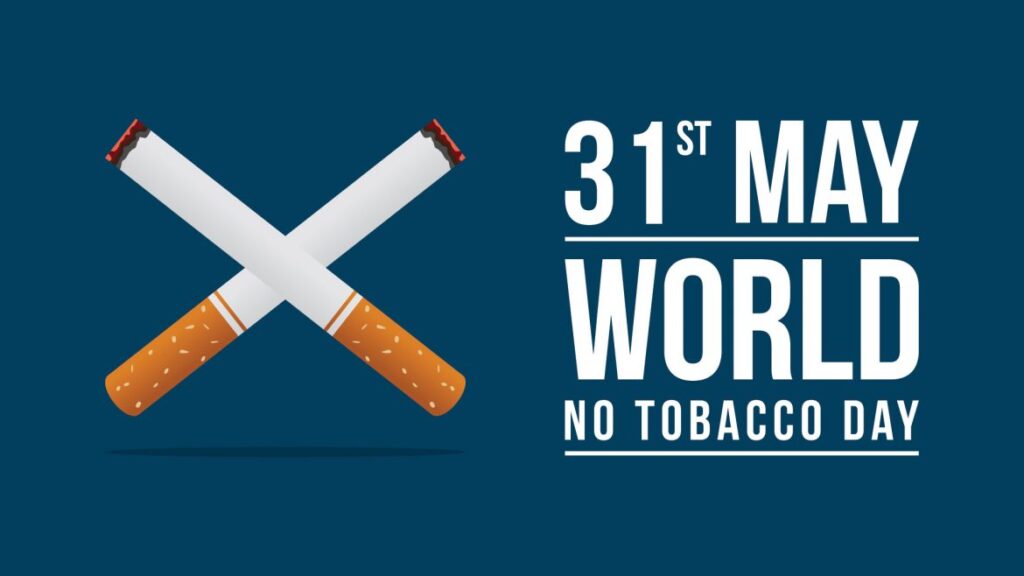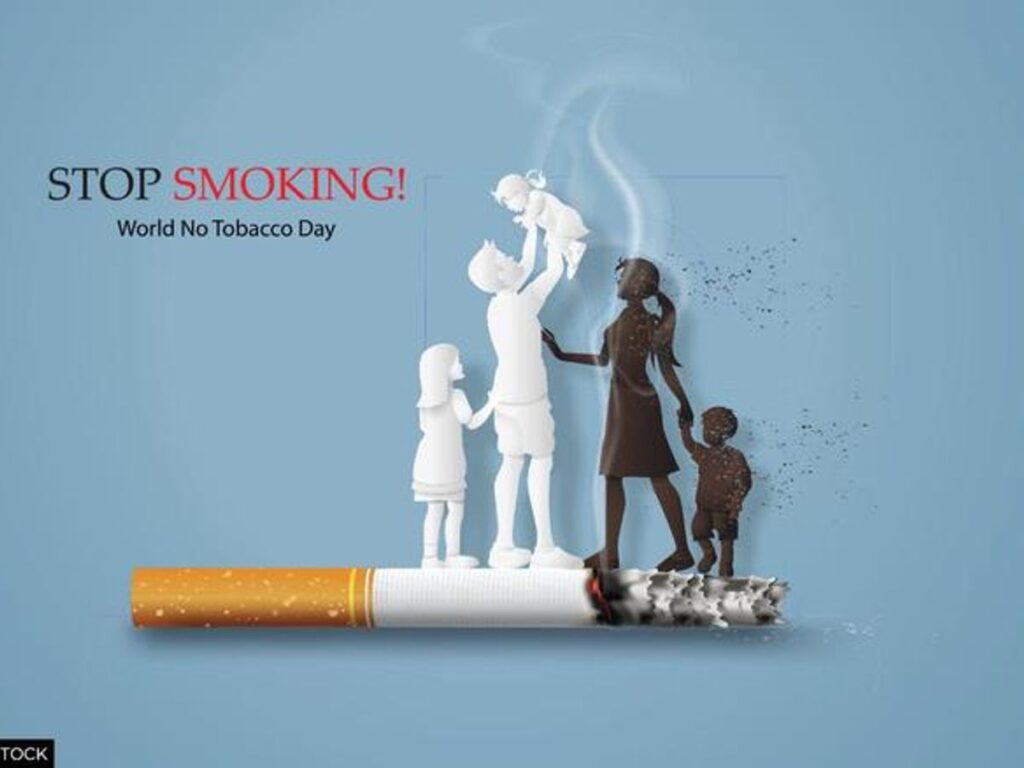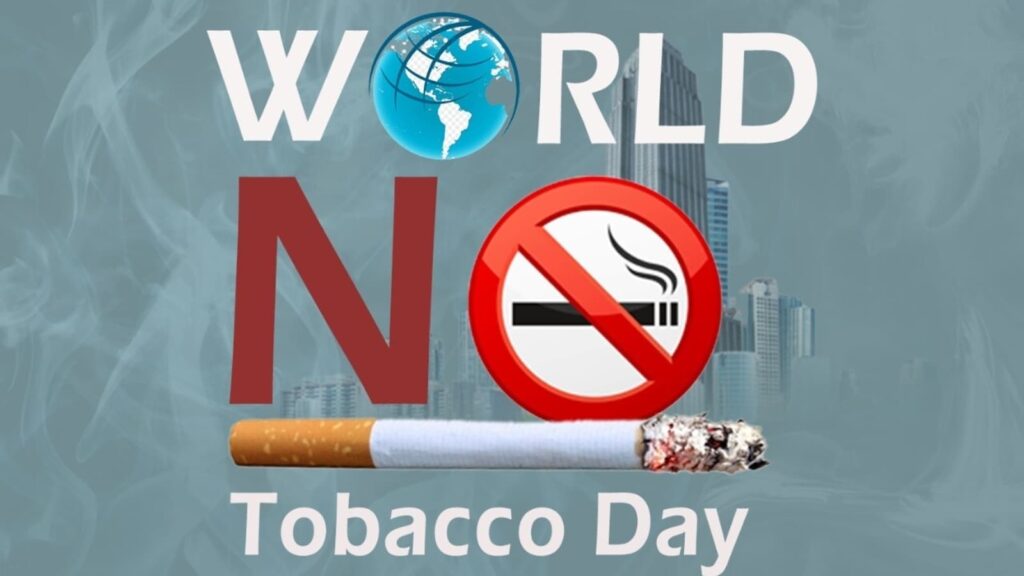World No Tobacco Day – “WHY Not Everyday”
Introduction:
World No Tobacco Day is observed on the 31st of May each year, serving as a reminder of the detrimental effects of tobacco consumption and highlighting the need for global tobacco control measures. Established by the World Health Organization (WHO) in 1987, this annual campaign aims to raise awareness about the dangers of tobacco use, advocate for effective policies to reduce tobacco consumption, and encourage individuals to quit smoking. As the leading cause of preventable deaths worldwide, tobacco poses a significant public health challenge, making World No Tobacco Day a crucial platform for action.
The Tobacco Epidemic:
Tobacco use remains a major global health concern, claiming the lives of more than 8 million people each year. Smoking not only causes a wide range of diseases such as cancer, heart disease, and respiratory ailments but also contributes to economic burdens, including increased healthcare costs and lost productivity. Additionally, secondhand smoke poses significant risks to non-smokers, particularly children, leading to increased respiratory problems and other health issues.

Key Objectives of World No Tobacco Day:
1. Raise Awareness: World No Tobacco Day serves as an opportunity to educate the public about the dangers of tobacco use, including the health risks associated with smoking, smokeless tobacco, and exposure to secondhand smoke. Through various awareness campaigns, the aim is to empower individuals with knowledge and encourage informed decisions about tobacco consumption.
2. Advocate for Effective Policies: This day prompts governments and organizations to implement and strengthen tobacco control policies. These may include measures like higher taxes on tobacco products, comprehensive advertising bans, graphic health warnings on cigarette packages, smoke-free laws, and access to smoking cessation programs. Advocacy efforts seek to create a supportive environment for individuals who want to quit smoking and discourage tobacco initiation.
3. Support Smoking Cessation: World No Tobacco Day encourages and supports individuals in their journey to quit smoking. Various resources, helplines, and initiatives are made available to assist smokers who wish to give up tobacco. The campaign aims to empower individuals to overcome addiction, improve their health, and reduce the risk of tobacco-related diseases.
Follow us on Youtube
Follow us on Facebook
Follow us on Twitter
Follow us on Instagram
Also Read 15 Landmarks To Visit Before You Turn 65
Global Impact of World No Tobacco Day:
Since its inception, World No Tobacco Day has played a vital role in shaping global tobacco control policies and reducing tobacco consumption. It has contributed to the adoption of the WHO Framework Convention on Tobacco Control (FCTC), a landmark treaty endorsed by 181 countries, which sets out guidelines for tobacco control at national and international levels.
The FCTC has led to the implementation of numerous evidence-based measures, resulting in significant progress in tobacco control worldwide. Countries that have adopted comprehensive tobacco control policies have witnessed a decline in smoking rates, increased awareness, and improved public health outcomes.
However, challenges persist, particularly in low- and middle-income countries where tobacco industry marketing remains rampant, and tobacco use rates are on the rise. World No Tobacco Day continues to be instrumental in bridging the gap, raising awareness, and fostering international collaboration to combat the tobacco epidemic.

Implications of Tobacco Use: Understanding the Consequences
Tobacco use has far-reaching implications that affect individuals, communities, and societies as a whole. From the personal health consequences to the socioeconomic burdens, the impacts of tobacco are significant and multifaceted. Here, we delve into the implications of tobacco use and shed light on the various dimensions affected by this global health challenge.
1. Personal Health Consequences:
Tobacco use is a leading cause of preventable deaths and a major contributor to various diseases. Smoking cigarettes, cigars, or pipes, as well as using smokeless tobacco products, can lead to serious health conditions such as:
a. Cancer: Tobacco consumption is a primary risk factor for numerous cancers, including lung, mouth, throat, esophagus, pancreas, kidney, bladder, and cervix cancer.
b. Cardiovascular Diseases: Smoking damages the heart and blood vessels, increasing the risk of heart attacks, strokes, coronary artery disease, and peripheral vascular disease.
c. Respiratory Diseases: Tobacco smoke damages the respiratory system, leading to chronic obstructive pulmonary disease (COPD), emphysema, chronic bronchitis, and respiratory infections.
d. Reproductive Health Issues: Smoking during pregnancy increases the risk of miscarriage, premature birth, low birth weight, stillbirth, and developmental issues in infants.
2. Economic Burdens:
The economic implications of tobacco use extend beyond the individual level and affect entire economies:
a. Healthcare Costs: Tobacco-related diseases place a significant burden on healthcare systems, resulting in increased healthcare costs, including treatment, hospitalizations, and long-term care.
b. Productivity Loss: Smoking-related illnesses, disability, and premature deaths contribute to productivity losses due to absenteeism, decreased work efficiency, and early retirement.
c. Socioeconomic Disparities: Tobacco use tends to be more prevalent among low-income individuals, exacerbating existing socioeconomic disparities and creating an additional financial burden on marginalized populations.
3. Environmental Impact:
Tobacco production and consumption also have adverse effects on the environment:
a. Deforestation: Tobacco cultivation requires significant amounts of land, often leading to deforestation. The loss of trees contributes to climate change and biodiversity loss.
b. Water Usage: Tobacco crops are water-intensive, putting pressure on water resources in regions where cultivation is prevalent, often exacerbating water scarcity issues.
c. Litter and Pollution: Tobacco product packaging, cigarette butts, and other tobacco waste contribute to environmental pollution. The toxic chemicals in cigarettes can contaminate soil, water bodies, and ecosystems.
4. Secondhand Smoke:
Secondhand smoke, the smoke exhaled by smokers or emitted from burning tobacco products, poses health risks to non-smokers:
a. Increased Disease Risk: Exposure to secondhand smoke can lead to the same health problems as active smoking, including respiratory issues, cardiovascular diseases, and cancer.
b. Vulnerable Populations: Children, pregnant women, the elderly, and individuals with pre-existing health conditions are particularly vulnerable to the harmful effects of secondhand smoke.
c. Social and Economic Costs: Secondhand smoke imposes additional healthcare costs and productivity losses on society, along with the emotional and psychological toll on affected individuals and families.
Addressing the Implications:
Recognizing the implications of tobacco use is crucial in implementing effective tobacco control measures:
1. Comprehensive Policies: Governments must adopt and enforce evidence-based policies, including higher taxes on tobacco products, advertising bans, graphic health warnings, and smoke-free laws, to reduce tobacco consumption.
2. Public Health Campaigns: Education and awareness campaigns play a vital role in informing the public about the dangers of tobacco use, promoting smoking cessation, and preventing tobacco initiation, particularly among youth.
3. Smoking Cessation Support: Accessible and affordable smoking cessation programs, nicotine replacement therapies, counseling services, and helplines should be available to individuals who want to quit smoking.
4. International Collaboration: Addressing the global tobacco epidemic requires collaboration among countries, international organizations, and civil society to share best practices, support capacity building, and advocate for stronger tobacco control measures worldwide.

Vaping
The health effects of vaping, or the use of electronic cigarettes, are still being studied and understood. While vaping is often promoted as a potentially safer alternative to traditional tobacco smoking, it is important to recognize that it is not without risks. Here are some key points to consider regarding the health implications of vaping:
1. Potential Harm Reduction: Some research suggests that vaping may be less harmful than traditional smoking because it eliminates the combustion process that occurs with burning tobacco, which produces harmful substances. Vaping devices heat a liquid (e-liquid) containing nicotine, flavorings, and other chemicals to create an aerosol that is inhaled. By avoiding combustion, users are exposed to fewer toxic chemicals found in cigarette smoke.
2. Nicotine Addiction: One significant concern with vaping is the potential for nicotine addiction. Nicotine is an addictive substance found in both traditional cigarettes and e-cigarettes. While e-cigarettes may deliver nicotine in lower amounts compared to combustible cigarettes, they still have the potential to create addiction and dependence, particularly among young people who may be more susceptible to its effects.
3. Respiratory Health Risks: Emerging evidence suggests that vaping can have adverse effects on respiratory health. Inhalation of the aerosol produced by e-cigarettes can lead to lung irritation, inflammation, and potential lung damage. Some studies have reported an association between vaping and lung injuries, including severe lung disease. However, further research is needed to fully understand the long-term effects on respiratory health.
4. Cardiovascular Risks: Nicotine, regardless of the delivery method, can have cardiovascular effects. It can increase heart rate, blood pressure, and arterial stiffness, which may contribute to an increased risk of heart disease and stroke. However, it is important to note that the specific cardiovascular risks associated with vaping are still being studied, and more research is needed to establish a clear understanding of the long-term effects.
5. Chemical Exposure: While vaping eliminates the combustion process, it does not mean that e-cigarettes are completely free of harmful chemicals. E-liquids can contain various chemicals, including volatile organic compounds, heavy metals, and potentially harmful flavoring agents. The specific health risks associated with these chemicals and their long-term effects are still being investigated.
6. Youth and Non-Smoker Concerns: Vaping has become increasingly popular among young people, including those who have never smoked traditional cigarettes. This trend raises concerns about nicotine addiction, gateway effects leading to cigarette smoking, and potential long-term health consequences among a vulnerable population.

Conclusion:
World No Tobacco Day serves as a global call to action, rallying governments, organizations, and individuals to join the fight against tobacco use. It highlights the urgent need for comprehensive tobacco control policies, effective public health campaigns, and robust support systems for smoking cessation. Through sustained efforts, it is possible to create a smoke-free future, protecting the health and well-being of current and future generations. Together, we can make a difference and pave the way for a healthier world.
Also Read
15 Landmarks To Visit Before You Turn 65
Rainwater Harvesting: An Eco-Friendly Approach to Water Conservation
Tabora: Exploring the Heart of Tanzania
25 South Indian Food Near Me In USA: Where Tradition Meets Taste
Ear Troubles? Learn How to Get Water Out of Your Ear

